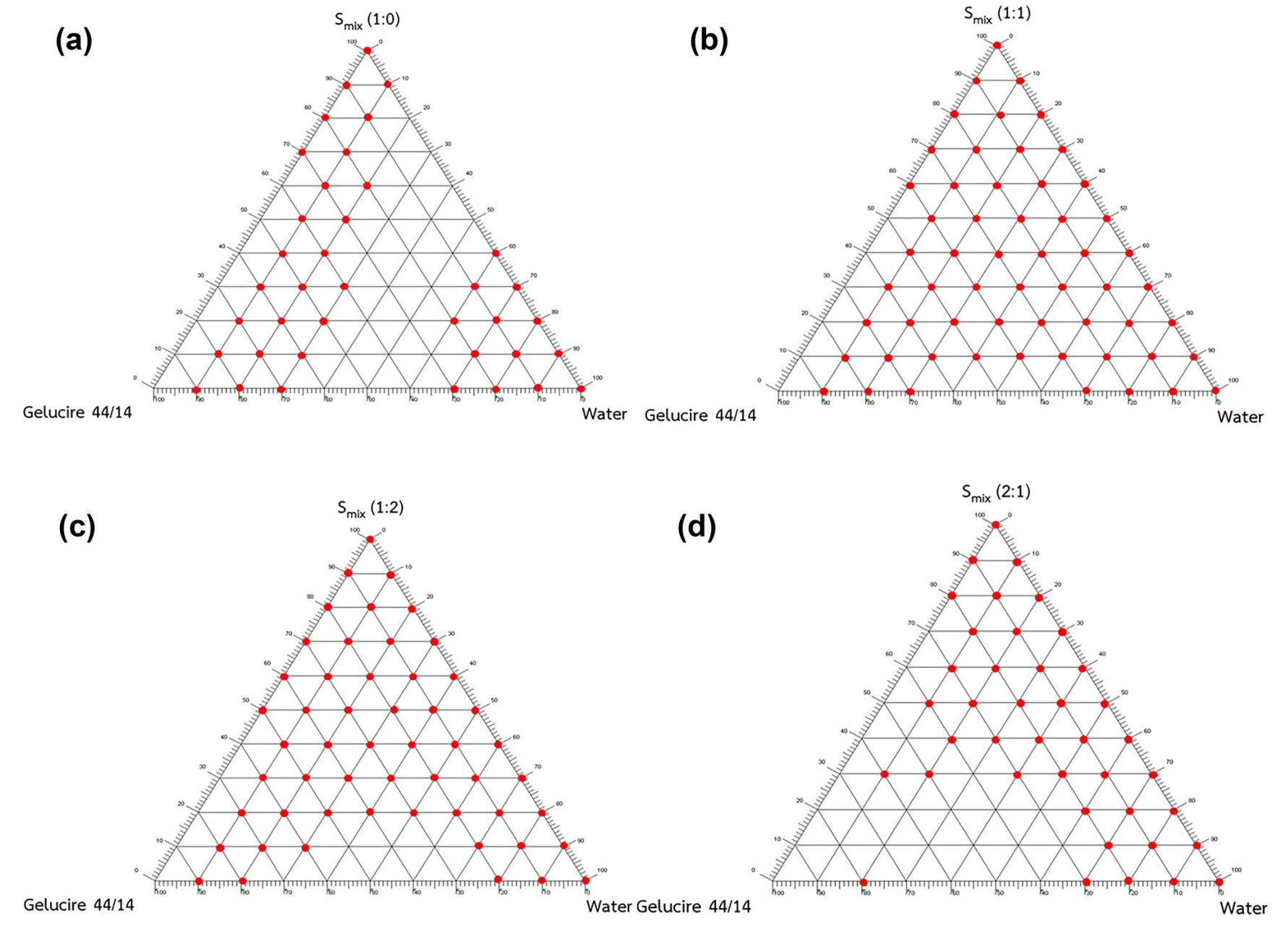Dissolution and antioxidant potential of apigenin self nanoemulsifying drug delivery system (SNEDDS) for oral delivery

Abstract
Self-nanoemulsifying drug delivery systems (SNEDDS) have been used to improve the oral bioavailability of various drugs. In the current study, apigenin was developed as SNEDDS to solve its dissolution problem and enhance oral bioavailability and antioxidant potential. SNEDDS were prepared by mixing Gelucire 44/14, Tween 80, and PEG 400 under controlled conditions. The droplet of diluted SNEDDS demonstrated a spherical shape with a size of less than 100 nm and a neutral charge. The very fast self-emulsification was obtained within 32 s, and the transmittance values exceeded 99%. The highest drug loading was 90.10 ± 0.24% of the initial load with the highest %encapsulation efficiency of 84.20 ± 0.03%. FT-IR and DSC spectra showed no interaction between components. The dissolution in buffer pH 1.2, 4.5, and 6.8 showed significantly higher dissolved apigenin than the apigenin coarse powder. The dissolution profiles were fitted to the Korsmeyer–Peppas kinetics. The cellular antioxidant activities in Caco-2 cells were approximately 52.25–54.64% compared to no treatment and were higher than the apigenin coarse powder (12.70%). Our work highlights the potential of SNEDDS to enhance the dissolution and permeability of apigenin and promote antioxidant efficacy, which has a strong chance of being developed as a bioactive compound for nutraceuticals.
Introduction
Apigenin is a major plant flavone derived from the Apium genus in the family Apiaceae, also known as the celery, carrot, or parsley family1. A great number of studies have revealed that apigenin is a bioactive compound that has a wide range of interesting pharmacological activities and nutraceutical potential, especially the well-known antioxidant properties2,3. Moreover, it has anti-inflammatory, anti-autoimmune, antihyperglycemic, antineurodegenerative, and anticancer activities4,5,6. Apigenin showed the high antioxidant capacity in 2,2-diphenyl-1-picrylhydrazyl (DPPH) and 2,2-azinobis-(3-ethylbenzothiazoline-6-sulfonate (ABTS+) colorimetric assays and photoprotective activity against UVA and UVB radiation in human keratinocytes7,8. Jung9 found that apigenin could reduce hydrogen peroxide (H2O2)-induced oxidative damage and cellular dysfunction in the mouse osteoblastic cell line MC3T3-E1. Al-Rawi et al.10 reported the antioxidant efficacy of apigenin by finding a significant decrease in brain tissue peroxidation in H2O2-induced oxidative stress in adult male rats. Due to these benefits, apigenin has gained attention for use in supplements and nutraceuticals. With a molecular weight of 270.24 Da, apigenin is soluble in dimethyl sulfoxide and hot ethanol but insoluble in water which is classified as a Biopharmaceutical classification system (BCS) Class II11. Therefore, its absorption and oral bioavailability are limited due to its poor water solubility.
The limited water solubility of active compounds is the major obstacle in the development of delivery systems. To obtain good bioavailability upon oral administration, the active compound has to be able to dissolve in the gastrointestinal (GI) fluid before its absorption into the systemic circulation12. Various delivery systems, including lipid-based delivery systems, have been employed to improve the dissolution and bioavailability of poorly water-soluble compounds. SNEDDS are one type of lipid-based delivery. They are anhydrous homogeneous liquid mixtures, composed of oil, surfactant, cosurfactant, and active compounds that spontaneously form transparent nanoemulsions upon aqueous dilution with the gentle agitation of GI motility13. SNEDDS provide advantages over ready-to-use nanoemulsions including improvement in the stability, the possibility of being manufactured as unit dosage forms, and an increase in patient acceptability. The components of SNEDDS help increase drug loading, dissolution, and permeability, which leads to an improvement in oral bioavailability14. In this study, a bioactive compound, apigenin, was loaded into SNEDDS to overcome its dissolution problem. The aim of the present work was to formulate, optimize, and characterize apigenin-loaded SNEDDS, as well as evaluate the dissolution and preliminary antioxidant potentials of the optimized formulations in Caco-2 cells to obtain good biopharmaceutical attributes for administration as oral supplements.
Download the full article as PDF here Dissolution and antioxidant potential of apigenin self nanoemulsifying drug delivery system (SNEDDS) for oral delivery
or read it here
Materials
Apigenin was purchased from Xian Neo Biotech, Xian, China. Corn oil was purchased from Morakot Industries, Thailand, and sunflower oil was obtained from Lam Soon, Thailand. Gelucire 44/14 (lauroyl polyoxyl-32 glycerides) and Transcutol HP (diethylene glycol monoethyl ether) were kindly supplied by Gattefossé, France. Myritol 318 (caprylic/capric triglyceride) was purchased from Chemipan, Thailand. Tween 20 (polyoxyethylene sorbitan monolaurate) and Tween 80 (polyoxyethylene sorbitan monooleate) were obtained from Ajax Finechem, Australia. Span 20 (sorbitan laurate) was obtained from Croda, Singapore. Span 80 (sorbitan monooleate) and Cremophor-RH40 (PEG-40 hydrogenated castor oil) were purchased from Namsiang, Thailand. PEG 400 was obtained from Krungthepchemi, Thailand. Hydroxypropyl methylcellulose (HPMC) capsules size 00 were obtained from Zhejiang Yuexi Capsule, Shaoxing, China. Dulbecco’s modified Eagle’s medium (DMEM), fetal bovine serum (FBS), Hank’s balanced salt solution (HBSS), phosphate-buffered saline (PBS), L-glutamine, penicillin, and streptomycin were supplied by Gibco, UK. 2,2ʹ-Azobis(2-methylpropionamidine) dihydrochloride (AAPH) and 2ʹ,7ʹ-dichlorodihydrofluorescein diacetate (DCFH-DA) were supplied by Sigma-Aldrich, MO, USA.
Morakul, B., Teeranachaideekul, V., Limwikrant, W. et al. Dissolution and antioxidant potential of apigenin self nanoemulsifying drug delivery system (SNEDDS) for oral delivery. Sci Rep 14, 8851 (2024). https://doi.org/10.1038/s41598-024-59617-z
Read more interessting articles on SNEDDS here:
- Formulating Resveratrol and Melatonin Self-Nanoemulsifying Drug Delivery Systems (SNEDDS) for Ocular Administration Using Design of Experiments
- A Quality by Design Approach for Developing SNEDDS Loaded with Vemurafenib for Enhanced Oral Bioavailability
- 3D printed capsule shells for personalized dosing of cyclosporine-loaded SNEDDS


